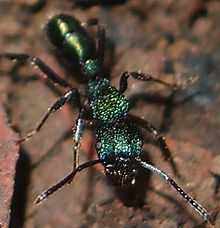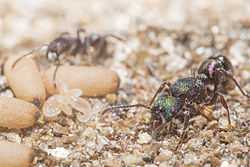Green-head ant
| Rhytidoponera metallica | |
|---|---|
 | |
| Many forms of Green-head ants have a distinctive metallic green exterior. | |
| Scientific classification | |
| Kingdom: | Animalia |
| Phylum: | Arthropoda |
| Class: | Insecta |
| Order: | Hymenoptera |
| Family: | Formicidae |
| Subfamily: | Ectatomminae |
| Genus: | Rhytidoponera |
| Species: | R. metallica |
| Binomial name | |
| Rhytidoponera metallica (Smith, 1858) | |
| Synonyms [1] | |
| |
The green-head ant, Rhytidoponera metallica, often simply referred to as the green ant, or sometimes the green-headed ant or in Queensland, the metallic pony ant, is a metallic-green coloured ant, generally 5–7 millimetres (0.20–0.28 in) in length,[2] that can be found throughout Australia, particularly in urban and suburban areas. It is often confused - verbally, not visually - with the weaver ant of northern Queensland, Australia, where it is also referred to as the green ant.

Green-head queens are semi-claustral, and forage for food themselves during the early stages of a colony. Queens are difficult to distinguish from workers, they generally have the same build, but are slightly larger with a more pronounced thorax and gaster. Workers forage alone and are omnivorous, however a majority of their diet consists of other insects. Colonies can range from small colonies, to large ones that can be around a metre deep into the ground and contain around a hundred workers.
Distribution and habitat
The green-head ant is a native species of Australia that is widespread throughout Victoria, New South Wales, the Australian Capital Territory and South Australia.[1] It can be found in most areas of Western Australia but is less common in the north, and is present in the lower regions of the Northern Territory and east of Queensland.[1] They are not present in Tasmania.
The habitat of the green-head varies, ranging from desert, open forests and woodland.[1] The species nests under ground.
Human interaction
The green-head ant is an infamous nuisance for suburban and urban dwellers in Australia. The ants generally build their nests underground beneath most types of grasses and often go unnoticed until someone, or sometimes some animal, is bitten. The actual ant's bite itself is often unnoticeable, however the venom that the ant injects via a stinger in its abdomen, initiates a sharp burning sensation beginning seconds after the sting and lasting up until any time from five minutes to as long as two hours or, with some subspecies, up to a day. Like the ants of the genus Myrmecia, the green-head ant is capable of causing anaphylactic shock in humans.[3] Most cases of anaphylaxis caused by the species is centered around areas in Queensland.[3]
-

Green-head ants near Mount Etna Caves National Park.
-

A green-head ant at 5x life size, demonstrating the colour.
References
- ↑ 1.0 1.1 1.2 1.3 "Species Rhytidoponera metallica (Smith, 1858)". Australian Faunal Directory. Department of the Environment, Water, Heritage and the Arts. 21 November 2008. Retrieved 17 April 2010.
- ↑ "Green-head Ant". Australian Museum. Retrieved 17 April 2010.
- ↑ 3.0 3.1 Brown, Simon G. A.; van Eeden, Pauline; Wiese, Michael D.; Mullins, Raymond J.; Solley, Graham O.; Puy, Robert; Taylor, Robert W.; Heddle, Robert J. (April 2011). "Causes of ant sting anaphylaxis in Australia: the Australian Ant Venom Allergy Study". The Medical Journal of Australia 195 (2): 69–73. Retrieved 12 February 2015.
External links
 Media related to Rhytidoponera metallica at Wikimedia Commons
Media related to Rhytidoponera metallica at Wikimedia Commons